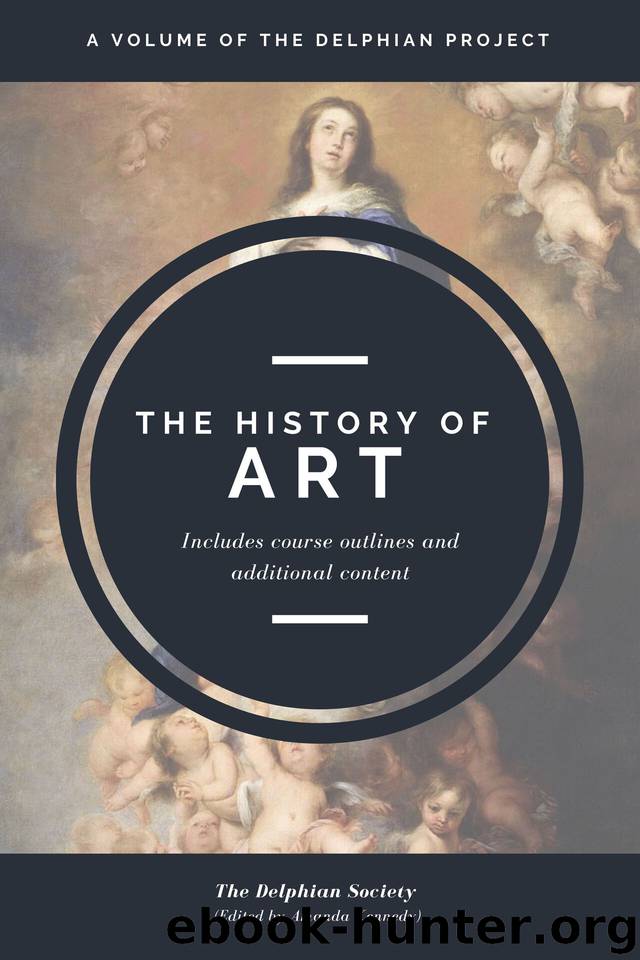The History of Art: A Volume of the Delphian Project by Kennedy Amanda & The Delphian Society

Author:Kennedy, Amanda & The Delphian Society [Kennedy, Amanda]
Language: eng
Format: epub
Published: 2020-06-19T16:00:00+00:00
CHAPTER IX
Painting in Germany
Little is known of the beginnings of German art. Probably the first paintings were made in Cologne, where we read of one Meister Wilhelm (Wilhelm von Herle) residing in the late Middle Ages. Cologne, beautiful in its situation upon the Rhine, appears to have stimulated a love of beauty in its artists. Pictures by Meister Wilhelm and his followers evince a certain mystic beauty, and their Madonnas are set in Paradises resembling flowery meadows. An old chronicle refers to Meister Wilhelm as one who "could paint a man as though he were alive." Several church paintings which were once thought to be his are now attributed to his pupils.
Meister Stephan (Stephan Lochner), although born in Constance, belongs to the Cologne school, having spent much of his time there. His Dom-bild (cathedral picture) is in one of the chapels of the Cologne Cathedral today. An altar-piece of three panels, the Adoration of the Magi, fills the inner panel, on one side guarded by St. George; on the other by St. Ursula sheltering her maidens. 23
Westphalia produced an early school of painters. Meister von Liesborn is associated with it. He is known to have painted a Crucifixion in 1456 for a Benedictine monastery near Munster. This was intended for an altarpiece, and consisted of several panels, which later were divided and scattered, today some are in one gallery, some in another.
Two other schools are known: the Swabian, founded by Martin Schongauer (1445-1491) and claiming the younger Holbein as its most distinguished follower; and that of Franconia, including painters of Nuremberg and culminating in the genius of Dürer.
Except for the work of the Primitives, who attained nothing of great value, but who laid the foundation upon which the two masters later built, German painting — until the last fifty years — has embraced little beside the paintings of Dürer and Holbein.
Hans Holbein, the elder, painted the Martyrdom of St. Sebastian in 1515, which is now preserved in the Munich Gallery He executed several pictures of merit, but until recently most of them were ascribed to his more talented son. Probably had it not been for the younger Holbein's attainments, his father's work would have received greater recognition.
Hans Holbein, the younger, (1497-1543), was born in Augsburg. When still a boy he removed to Basle, where his early work was done. Most of his later life was spent in England. Basle was a city of learning, and it was the boast of its citizens that every home sheltered at least one scholar. It was a center for the Humanists, and Holbein appears to have been soon associated with Frobenius, a printer of their publications. Woodcuts for book designs were in constant demand, and Holbein prepared a series of them on the theme Dance of Death. This was by no means an original subject. In the first place, the priests probably associated the picture of the dead by the living — thus to impress the idea of death's ever-presence; in time the figure of Death was substituted.
Download
This site does not store any files on its server. We only index and link to content provided by other sites. Please contact the content providers to delete copyright contents if any and email us, we'll remove relevant links or contents immediately.
The Secret History by Donna Tartt(18161)
Red Sparrow by Jason Matthews(5195)
Harry Potter 02 & The Chamber Of Secrets (Illustrated) by J.K. Rowling(3555)
In a Sunburned Country by Bill Bryson(3367)
Drawing Cutting Edge Anatomy by Christopher Hart(3290)
Figure Drawing for Artists by Steve Huston(3269)
The Daily Stoic by Holiday Ryan & Hanselman Stephen(3109)
Harry Potter and the Prisoner of Azkaban (Book 3) by J. K. Rowling(3109)
Japanese Design by Patricia J. Graham(3000)
The Roots of Romanticism (Second Edition) by Berlin Isaiah Hardy Henry Gray John(2819)
Make Comics Like the Pros by Greg Pak(2758)
Stacked Decks by The Rotenberg Collection(2685)
Harry Potter and the Deathly Hallows (7) by J.K. Rowling(2550)
Draw-A-Saurus by James Silvani(2503)
Tattoo Art by Doralba Picerno(2486)
On Photography by Susan Sontag(2482)
Foreign Devils on the Silk Road: The Search for the Lost Treasures of Central Asia by Peter Hopkirk(2388)
Churchill by Paul Johnson(2362)
The Daily Stoic by Ryan Holiday & Stephen Hanselman(2343)
